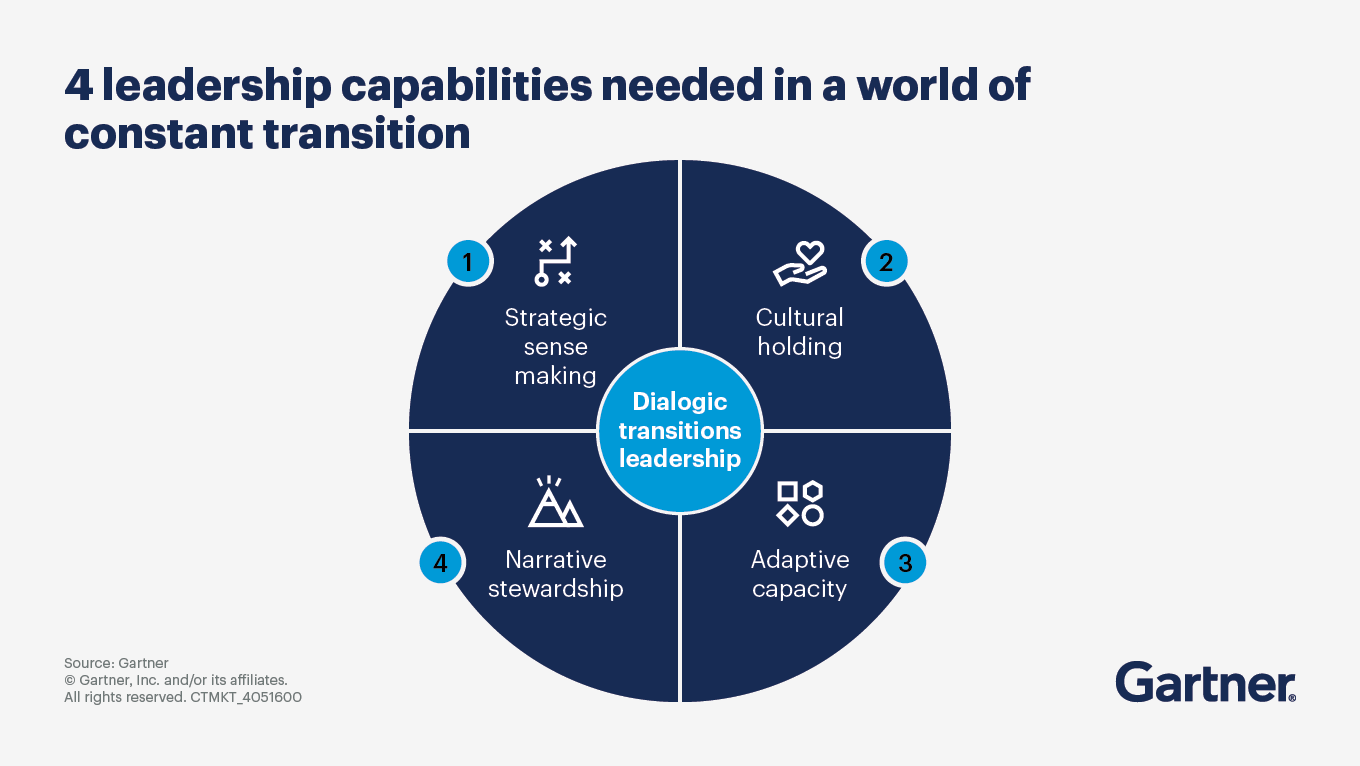The real differentiator is how you help your organization adapt — not just react.
- Gartner client? Log in for personalized search results.
Organizational change is an enterprisewide leadership challenge
Across industries, organizations are contending with overlapping pressures: digital acceleration, AI adoption, sustainability mandates and evolving workforce expectations, to name just a few. Change is no longer episodic or neatly contained within a single initiative. Instead, it has become a continuous condition — one that calls for new mindsets and approaches to leadership.
Thriving in this environment requires building the capacity to navigate ambiguity, foster resilience and transform uncertainty into forward momentum.
Want deeper insights on organizational change? AskGartner gives clients immediate answers backed by Gartner’s expert insights.
Organizational change requires adaptive leadership — not just new messaging
Traditional playbooks assume change is linear. In reality, organizational change is far messier. Employees are managing emotional backlogs from multiple, concurrent transitions. To drive true business transformation, move beyond control and communication to hosting dialogue that builds trust and enables adaptive capacity at every level.
Use strategic sense-making to make organizational change manageable
When transitions overlap, patterns and pain points emerge fast. Sense-making starts when you invite diverse voices — stakeholders with different priorities, internal influencers who informally shape culture, and outside experts who see blind spots employees might miss — into the conversation.
Use after-action reviews or scenario planning as opportunities for discovery. Ask questions like:
What themes are surfacing across all our changes?
What are we missing beneath the surface?
Who’s being impacted in unexpected ways?
This approach helps your team see connections others overlook and spot risks before they cascade.
Build trust and resilience during business transformation
Planning is necessary, but it won’t get people through the emotional churn of constant transition. Psychological safety is essential for engagement and innovation when routines are disrupted. Be present for, and empathic to, how changes land across the organization. Create intentional spaces where employees can share uncertainty or challenge assumptions without fear of backlash. Rituals — from retrospectives to informal check-ins — help teams process loss and reorient around new goals.
Ask yourself:
Where are people struggling to let go of old ways?
How do we help teams accept what’s lost and celebrate what’s emerging?
Which behaviors need amplifying as we evolve?
Grow adaptive capacity through experimentation
Successful organizations experiment continuously. Distributed decision making builds agility by empowering teams closest to problems to try new, sometimes imperfect approaches. To support this:
Invest in coaching and cross-functional collaboration so learning happens everywhere, not just at the top.
Encourage safe-to-fail pilots rather than demanding perfection up front. Reward curiosity over certainty.
Use friction as fuel for growth by asking what can be learned from resistance or setbacks.
Leverage communities of practice so employees can share lessons learned across silos.
Shape the narrative with transparency
Uncertainty creates stories — sometimes helpful, sometimes damaging. As a leader, you have outsize influence over which narratives take hold during transition. Share openly what’s known and unknown. Explain the rationale behind decisions. Invite feedback in both directions so employees feel part of shaping strategy.
A strong narrative doesn’t ignore ambiguity. It acknowledges paradoxes and invites participation in co-authoring a vision.
Organizational change FAQs
How have the principles of organizational change evolved?
Today’s organizations are in a constant state of transition, and organizational change can no longer be managed as a single activity — making traditional phased change management approaches and frameworks less effective. To succeed, organizations need a conversational change leadership approach that promotes agility and adaptability.
How can leaders help employees navigate organizational change?
An environment of psychological safety is key to helping an organization navigate transitions. Modern change management approaches ensure that employees are included in the conversation and can freely learn, contribute and even challenge new approaches without negative consequences. This helps build employee resilience, improves change adoption and fosters higher engagement and performance.
Attend a Conference
Accelerate growth with Gartner conferences
Gain exclusive insights on the latest trends, receive one-on-one guidance from a Gartner expert, network with a community of your peers and leave ready to tackle your mission-critical priorities.

Drive stronger performance on your mission-critical priorities.
